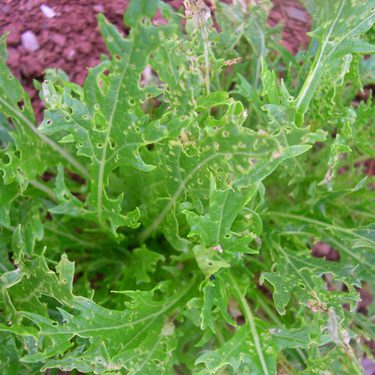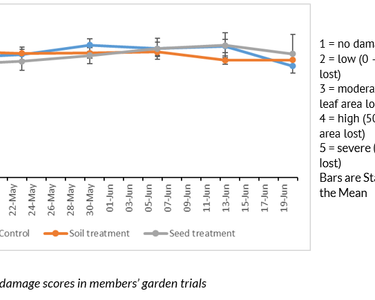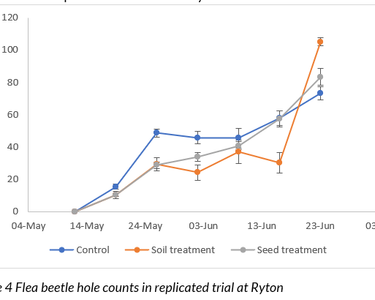
Testing a novel biostimulant against flea beetle
- Tags
- Members experiment archive

Summary
Garden Organic was approached by NIAB (National Institute of Agricultural Botany) to test a biostimulant, that is applied as a seed coating (developed by Wasware). The biostimulant is made from ‘frass’ the droppings and insect casings of the maggot of the black soldier fly. These are fed on food waste, giving the product good sustainability credentials. The biostimulant has a high chitin content, which is thought to stimulate the plant’s natural defence mechanisms against insect attack.
We conducted a small trial in 2021 which showed that the biostimulant had a small effect on reducing flea beetle damage in oriental mustard leaves, but the effects were not statistically significant. We wanted to investigate this effect further, so we repeated the trial with a larger sample of people in 2022, this time growing rocket which is also very susceptible to the pest. Tests in 2022 showed similar effects: applying the seed coating resulted in a small reduction in damage from flea beetle. Although these differences were too small to be statistically significant, they were observed on repeated occasions both in the members’ garden trials and in replicated trial at Ryton.
We concluded that there needs to be further detailed work research on this treatment before further citizen science trials are done with the public in a garden setting. Biological treatments often need to be applied under very specific conditions, so we need a deeper understanding of the mode of action, to ensure that the treatment is applied optimally.
Introduction
Brassicas could be considered one of the most pest prone group of crops, but they are also the most widely grown. A common pest is the flea beetle (Psylliodes and Phyllotreta spp.) which is widespread and has been on the increase in the last few years. The adults are easily recognisable as small shiny black beetles that jump like fleas when disturbed. They are most of a problem in seedlings where the adult beetles (and to a lesser extent, the larvae) eat at the stems and can kill plants as they emerge by damaging the growing point. The adults can also render brassica salad crops such as rocket, mizuna and mustards inedible by ‘peppering’ the leaves with lots of small holes.
There are a number of different species of flea beetle that attack brassica plants, at different times of year. The cabbage stem flea beetle (Psylliodes chrysocephala) which attacks oilseed rape as it emerges, is perhaps considered the pest with most widespread impact in agriculture. Currently there are few effective treatments available. Neonicotinoids were used extensively until their use was restricted in 2013, but it has also developed resistance to most other pesticides used in the UK (Willis et al 2020). In organic gardens, mesh netting is sometimes recommended, but its effectiveness is limited, as it tends to just trap the pest under the netting.
A number of alternative biological treatments are currently being investigated at Harper Adams University including use of nematodes, soap sprays and soil-dwelling bacteria (Bacillus thurengiensis) (Price et al, 2023). NIAB have also been investigating a biostimulant, that is applied as a seed coating developed by Wasware. The biostimulant is made from ‘frass’ the droppings and insect casings of the maggot of the black soldier fly. These are fed on food waste, giving the product good sustainability credentials. The biostimulant has a high chitin content, which is thought to stimulate the plant’s natural defence mechanisms against insect attack, and perhaps other pests such as slugs too. Chitin has been shown to have direct effects as a biopesticide against a range of insect pests including aphids and moths (Sharp, 2013). Chitin not only acts as a biopesticide but can induce protection in the plants themselves. Chitin and its extract chitosan has been shown to bind to specific receptors triggering stress response in plants leading to physiological changes providing protection against fungal pathogens and abiotic stress such as drought and cold stress (Du Jardin, 2015). Haas et al (2018) also found that priming seed with chitosan increased defence of brassica plants against a range of sucking and chewing pests, reducing their egg laying. This alternative approach should have very little impact on wildlife and non-target organisms, compared to using a systemic pesticide.
Garden Organic were approached by NIAB to trial this new approach with its members. We conducted a small trial in 2021 which showed that the biostimulant had a small effect on reducing flea beetle damage in oriental mustard leaves, but the effects were not statistically significant. We wanted to investigate this effect further, so we repeated the trial with a larger sample of people in 2022, this time growing rocket which is also very susceptible to the pest.
Aims of this experiment
To test the effects of a novel biostimulant on levels of pest damage, applied as a soil amendment and a seed coating, on growth and pest damage on rocket plants.
Rocket is a quick growing salad crop but is frequently damaged by flea beetle as the leaves emerge and the leaves are also subsequently peppered with holes rendering the salad inedible. The variety Rucola was chosen as it is a salad variety that is susceptible to flea beetle but is slower to bolt than some other salad varieties.
Methods
Preparation and sowing
It was decided to conduct the trial in pots in 2022, to reduce the amount of slug damage which destroyed a large number of the plants in 2021 and made it difficult to assess the flea beetle damage.
- 3 x 20 cm pots were filled with peat free multipurpose compost
- Pots were labelled: 1 Control, 2 Soil treatment, 3 Seed treatment
- In pot 2 the soil treatment was applied by lightly mixing into the top third of the compost
- 20 seeds were sown in each pot:

Assessing emergence
- On a daily basis, the number of seedlings in each pot was counted until the numbers stopped increasing.
Assessing pest damage
Damage from slugs, flea beetles, and aphids was assessed on a weekly basis until the plants flowered and leaf production ceased.
Leaf pest damage for slugs and flea beetle was assessed using the following scale:
1 = no damage,
2 = low (0 – 24% leaf area lost)
3 = moderate (25 – 49% leaf area lost)
4 = high (50 – 75% leaf area lost)
5 = severe (>75% leaf area lost)
Additionally flea beetle damage was assessed by counting the number of holes on 5 leaves selected at random, a modified method used by Lamb (1980).
Aphids
Aphid damage was assessed according to the following scale modified after Mensah et al. (2005)
1 – No aphids
2 – Very low infestation, 1 or 2 visible on a few leaves, plants healthy
3 – Moderate infestation mostly on young leaves and at tops of stems, plant healthy
4 - Heavy infestation, aphids on most leaves and stems, leaves crinkled
5 – Very heavy infestation on most leaves and stems, leaves crinkled and yellow, sooty black mould
Analysis
The experiment was analysed using one way Analysis of Variance of the soil and seed treatments and the sites treated as blocks. This test was able to analyse the main effects (ie site and treatment) but, due to the lack of replication at each site, it was not possible to analyse the interaction between the treatments (ie whether the treatments had different effects at different sites). Additionally, a randomised block trial with 5 replicates was carried out at Ryton.
Results
Common pests
Participants were questioned about the extent to which three key pests were a problem at their site. Slugs were by far the most common problem, with 95% stating that they regularly or always occurred. Aphids were also regularly occurred for 87% of participants. The incidence of flea beetle, at 60% of participants, was lower but still a significant proportion. Similar incidences of pest damage were found in 2021.
Table 1 Occurrence of pests in rocket with our members
%participants | Fleabeetles | Slugs | Aphids | ||||
Never occurs | 11.5 | 1.3 | 0.0 | ||||
Occasionally occurs (less than 1 in 5 years) | 14.1 | 2.5 | 2.5 | ||||
Sometimes occurs (eg 1 in 3 years) | 14.1 | 1.3 | 10.1 | ||||
Regularly occurs (most years) | 33.3 | 21.5 | 32.9 | ||||
Always occurs (every year) | 26.9 | 73.4 | 54.4 | ||||
Table 2 Emergence counts in members’ garden trials
Untreated | Soil treatment | Seed treatment | |
Mean | 16.5 | 14.6 | 14.0 |
Standard error of mean | 0.798 | 1.107 | 0.647 |
Both the soil treatment and seed treatment slightly reduced the final emergence by 11% and 15% respectively and this effect was statistically significant (One Way ANOVA, p=0.036). It is possible that the soil treatment changed the conductivity of the soil (increased the concentration of dissolved substances in the soil solution), slightly reducing the emergence. It is well established that increased soil conductivity reduces germination, and this has been shown to occur in brassicas (Williams and Shaykewich, 1971). Although these reductions were statistically significant, it may be considered a worthwhile sacrifice if there are gains to be made from protecting the crop against pests.
Slug Damage
Slug damage was a problem that made it difficult to analyse many of the plots with large numbers of missing plants in 2021. This was less of a problem in 2022, due to the decision to grow the plants in pots. Slug levels were generally low, with either no or low levels of damage. There were no trends or significant effects of the treatments.

Flea beetle damage
Flea beetle damage was also at low levels early in the growing season during May and June, with most plants sustaining low levels of damage. As levels were low, it was difficult to see any differences between treatments when evaluating them visually using a damage score.
Later in the season, in July and August, there were very high numbers of flea beetle, but this was after the rocket had gone to seed and finished growing.

As an alternative way of recording the damage inflicted by flea beetle, participants were asked to count the number of holes made by the pest on five leaves. This method is more time consuming, but more sensitive than the visual scoring method, so is more likely to be able to detect any differences between treatments.

Seed treatment slightly reduced the number of holes chewed by the pest, on 30 May, 6 June, 13 June and 20 June, and although the effects were not significant (using one way ANOVA test) there was a consistent trend.
The soil treatment had higher number of hole counts on 20 June, but there was a large amount of variability in these results so this effect might not be real.
A randomised replicated block trial at Ryton was also carried out.

Consistent with the members’ garden trial results, there was a trend for the seed treatment to reduce the number of fleabeetle holes on 24 May and 3 June. The soil treatment also reduced the number of holes on 24 May, 3 June and 20 June. This effect was significant (p = 0.0424, ie only a 4% chance that these results happened by chance) on the 24 May but not on other dates.
Aphid damage
Aphid damage was extremely low during the period of the experiment, so the results are not presented here.
Other observations from participants
Many of the participants commented that the soil treatment affected the growth of the rocket. However the observations were mixed with some people stating that the soil treatment hindered emergence and growth of the plants whereas others stated that it greatly improved the growth and vigour of the plants. Data from the manufacturers of the frass soil amendment showed that the product contained 3% nitrogen, 1% phosphorus and 4% potassium, so it is likely that the product boosted plant growth by increasing nutrient availability.
Conclusions
The results from this year and 2021 suggest that there was a repeated trend for the seed treatment to result in a small reduction in flea beetle damage. However there needs to be further work to ascertain the significance of these effects. Often biological controls have very specific criteria under which they have be to applied in order to be effective, so it is likely that the effectiveness of the treatment varied under the wide range of conditions in the various member’ gardens.
In order to maximise the potential for use of frass a biostimulant against flea beetle, we need a better understanding of its mode of action, so that we can learn the best way to apply it. Research into this requires detailed replicated trials with intense observations. This is beyond the scope of a citizen science experiment where trials need to be kept simple and detailed observations can be limited by people’s spare time and experience.
This may be an interesting topic to revisit, once more is known about the action of chitin based biostimulants and the best way to apply them.
References
Du Jardin, P. (2015). Plant biostimulants: definition, concept, main categories and regulation. Scientia Horticulturae, 196, 3-14.
Haas, J., Lozano, E. R., Haida, K. S., Mazaro, S. M., de Souza Vismara, E., & Poppy, G. M. (2018). Getting ready for battle: do cabbage seeds treated with jasmonic acid and chitosan affect chewing and sap‐feeding insects?. Entomologia Experimentalis et Applicata, 166(5), 412-419.
Lamb, R. J. (1980). Hairs protect pods of mustard (brassica hirta’gisilba’) from flea beetle feeding damage. Canadian Journal of Plant Science, 60(4), 1439-1440.
Mensah, C., DiFonzo, C., Nelson, R. L., & Wang, D. (2005). Resistance to soybean aphid in early maturing soybean germplasm.
Price, C., Pope, T. and Campbell, H. Potential of biopesticides and optimising use of conventional insecticides for control of cabbage stem flea beetle (Psylliodes chrysocephala) PhD project webpage.
Sharp, R. G. (2013). A review of the applications of chitin and its derivatives in agriculture to modify plant-microbial interactions and improve crop yields. Agronomy, 3(4), 757-793.
Williams, J., and Shaykewich, C.F. "Influence of soil water matric potential and hydraulic conductivity on the germination of rape (Brassica napus L.)." Journal of Experimental Botany 22.3 (1971): 586-597.
Willis, C. E., Foster, S. P., Zimmer, C. T., Elias, J., Chang, X., Field, L. M., ... & Davies, T. E. (2020). Investigating the status of pyrethroid resistance in UK populations of the cabbage stem flea beetle (Psylliodes chrysocephala). Crop Protection, 138, 105316.